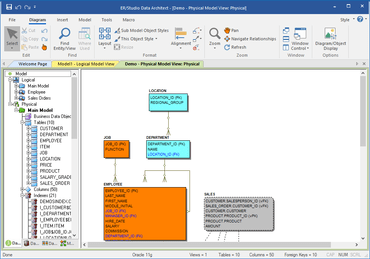Adds support for MongoDB 4.x along with support for importing JSON Objects from JSON documents.
June 10, 2022
New Version
Features
- Added support for MongoDB 4.x - This release includes tolerance support for MongoDB 4.0-4.4.
- Added SCRAM authentication option as default for MongoDB.
- Added support for importing JSON Objects from JSON documents - ER/Studio Data Architect now lets you create a data model by importing JSON files using a JSON document, in .json or .txt format. Importing these files allows you to create a MongoDB physical model or JSON Instance physical model.
- Added support for switching a MongoDB object's class between Collection and Nested Object.
- Improved Logical to Physical conversion to MongoDB - This release includes two new Relationship Type options in the Logical Relationships Editor to allow users to decide the direction of containment relationships.
- Improved compare/merge options to MongoDB Physical Models.
- Added support for repeated Elements in hierarchical Models.
- Added Denormalization tools for hierarchical Objects - New Denormalization Tools are now available from the Insert ribbon for all hierarchical models.
- Options include:
- Rollups.
- Rolldowns.
- Table Merges.
- Horizontal Splits.
- Vertical Splits.
- Containment relationships are enabled for hierarchical models when the tables are linked via a containment relationship, the child object is rolled up into the parent. Opposite is true for roll down.
- Added source code in the Object Editor JSON tab.
- Added a relationship validity check and display - Relationships that include an error are now marked with a universal "no" symbol. Error conditions include:
- A referencing relationship where the parent object is a Nested Object and the Parent Key property (Properties tab) of the relationship is Primary Key. If the user changes to an alternate key, then the relationship should be valid.
- A containment relationship where a Collection is the contained object.
- Added support for hierarchical visualization of MongoDB, XML, and JSON - This release includes the following improvements to support a hierarchical visualization of MongoDB, XML, and JSON content:
- Added a roll-up view for hierarchical Models including expand/contract icons and Repeated Object icons for nested Objects:
- In the Diagram and Display Options dialog > Object tab, check Roll Up Contained Objects to cause the display of the current submodel to change between the standard graph structure and a rolled-up, nested style.
- If you choose other submodels in the Apply To tab, this setting also applies to those submodels if they are part of hierarchical models.
- If Logical submodels and standard RDBMS Physical submodels are selected in the Apply To tab, property changes are applied but do not appear any differently. Only top-level objects, such as Collections plus any objects that are not contained by another object, remain in the diagram view.
- For MongoDB models, this includes all Collections but may also include orphaned nested objects. JSON models do not include collections so it would be any object that is not the child of a containment relationship.
- Expand/Contract Icons - The rolled-up view includes expand (+) and contract (-) icons for you to manage your data more effectively.
- Repeated Object Icons - Within the rolled-up view, fields that represent nested objects are shown by using the following "repeated object" icons:
- Unique to parent.
- Used elsewhere - I.e. has other containment relationships that are contained within.
- Note that some nested objects can appear under multiple parent objects (Collections or other Nested Objects), but others are unique to single parent objects.
- Keyboard Entry Tools - Another feature of the rolled-up view is functionality that allows you to quickly add and modify fields to a nested structure inside the rolled-up view for hierarchical models. Simply press ENTER on your keyboard, and a dialog appears to allow you to select options for nested objects.
- Move Functionality - Use the Move (cursor finger) function to move Attributes/Columns from one Entity/Table to another or move within an entity or view. Other attributes of the Move functionality include:
- When used within a Collection, you can move a Field within a containing parent object or across parent objects.
- When you move a Field that is an FK field for a containment relationship, all substructures move with it. This also allows for the movement of nested objects between Collections.
- When you move a Field that is an FK field for a referencing relationship, a copy of that field is made as per current behavior, leaving the existing FK unchanged.
- Added the ability for users to set data types during In Place Editing - Users can now set data types while editing/adding a column using SHIFT+CLICK. You can enable/disable this feature using Allow set data types dialog in the Options dialog for Diagrams, accessible by clicking Tools > Options > Diagram.
- Added a parent/child Entity switch icon in Table Editor - Using the Switch icon in the Table Editor, you can easily switch the view from child Entity to parent Entity for that selected row.
- Added support for JSON Instance files - This release includes tolerance support for JSON Instance.
- Added the ability for users to switch between MongoDB and JSON Instance hierarchical platforms - Users now can switch the database platform of a physical data model ONLY between hierarchical model platforms. Use Change Database Platform to switch from MongoDB to JSON Instance and vice versa, but not to any non-hierarchical platforms.
ER/Studio Data Architect Multiplatform
Design, modeling and collaboration solution for Enterprise information architects.
Got a Question?
Live Chat with our IDERA licensing specialists now.

Official Distributor since 2013
